The ABC's of February: Art Fairs, the Breakfast Business & Corona Beer vs. Coronavirus
ART
Content Courtesy of: artnews.com
Written by: Maximilíano Durón
Travel-Intensive Art Fairs Respond to Growing Coronavirus Anxiety Around the Globe

The European Fine Art Fair (TEFAF) in Maastricht, the Netherlands in 2015. The fair said its 2020 edition, scheduled for early March, will go on as planned. MARCEL VAN HOORN/EPA/SHUTTERSTOCK
As reports of new coronavirus cases continue to accumulate around the world, well-traveled art fairs with international clienteles have been appraising their plans. The biggest ones in the coming months have said they so far intend to go on as scheduled, while others—including two in Milan—have announced postponements or changes to their schedules.
The Armory Show, a marquee event in New York with VIP previews starting next Wednesday, released a statement earlier this week saying it will go on as planned, while the ADAA Art Show on Manhattan’s Upper East Side is already under way.
The upcoming European Fine Art Fair (TEFAF)—a two-week affair scheduled for March 7-15 in Maastricht, the Netherlands—issued a statement on Thursday detailing “measures TEFAF is taking to provide a safe environment for all exhibitors, visitors, and our staff.” These include increasing “precautionary measures, such as additional all-day cleaning services and distribution and placement of hand sanitizers at the fair,” in addition to working with a first-aid team that will be in direct contact with the Maastricht university hospital.
TEFAF cited a statement from Maastricht mayor Annemarie Penn-te Strake, with whom the decision to continue with the fair ultimately lies: “The mayor is in constant contact with these institutions. Both bodies have, at present, given no advice which would make the Mayor decide to reconsider TEFAF’s Fair. The Mayor will continue to have daily consultations with the relevant health and security institutions.”
One of the next major fairs on the calendar is SP-Arte in São Paulo, scheduled for April 1–5. Though Brazil’s first case of coronavirus was reported earlier this week, the fair organizers said it was too soon to decide on the fate of the fair. In a statement sent to ARTnews, SP-Arte’s founder and director Fernanda Feitosa said, “It is early to tell what the impact of coronavirus in Brazil will be. This is a global concern, and for now we will remain alert. We will, of course, monitor official information coming from the World Health Organization and follow any recommendations they may issue for the region as well as recommendations from Brazilian health authorities.”
In one the most momentous coronavirus-related announcements of late, the Swiss government on Friday declared a ban on gatherings of more than 1,000 people. In response, the MCH Group—the parent company of the big Art Basel fair in Switzerland and others around the globe—was forced to move its upcoming Baselworld Watch and Jewellery Show from an opening in late March until next January.
In a statement, a spokesperson for Art Basel—scheduled for June 16-21—said the plan remains in place and that the fair is “taking the situation extremely seriously” while preparing to “take any necessary measures in order to safely hold the fair.” Art Basel just released its exhibitor list on Wednesday, after being forced to cancel Art Basel Hong Kong, which had been slated for March.
Guillaume Piens, the director of the Art Paris fair scheduled for April 2-5, told ARTnews that, while the coronavirus is “a very serious situation,” his feeling is that “there’s too much hysteria about it at the same time. I’m afraid that the media hysteria around the virus might be worse than the plague.” With a few dozen cases reported in France, Piens said the fair would go on as planned—adding that though exhibitors from South Korea and Italy have been in contact about their participation, they too would still plan to forge ahead.
“A lot of people are mixing all the information,” Piens said. “People are talking about Hong Kong. There were already a lot of political problems before in Hong Kong. It was already a difficult situation that they had to deal with, and the virus was the nail in the coffin. The deaths in Hong Kong are at very low rates. We’re following the situation and monitoring it, and, of course, we take it very seriously. But at the same time we really want to stay calm and not panic.”
Two Italians fairs scheduled to open in Milan—one of the cities hardest hit by a series of outbreaks in northern Italy—have postponed their upcoming editions. The Salone del Mobile furniture fair is moving from April to June, and the MIA Photo Fair scheduled to open March 19 has not yet released new dates.
Other fairs coming soon that have not issued statements of any kind include Art Dubai (March 25–28), PAD Paris Art + Design (April 1–5), Paris Photo New York (April 2–5), Printed Matter’s L.A. Art Book Fair (April 3–5), and the Affordable Art Fair, which has back-to-back editions planned in Brussels (March 20–22) and New York (March 26–29).
Content Courtesy of: artnews.com
Written by: Sarah Douglas
Fake News and Real Sales Arrive in Full Form at the Felix L.A. Art Fair’s Second Edition

The Hollywood Roosevelt Hotel, where Felix L.A. is held. ILPO MUSTO/SHUTTERSTOCK.
Occupying a room on the 11th floor of the Hollywood Roosevelt Hotel, as part of the second edition of the Felix L.A. art fair, is a gallery based in Athens, Greece, called Fomo Haber. The two young men who work there are L.A. locals. One is a musician, the other works for Hauser & Wirth. The proprietors of Fomo Haber had “visa problems,” these two will tell you, and couldn’t make it, so they were hired at the last minute.
In fact, the “gallery” is an installation by Darren Bader, who has faked every aspect of it, from the enterprise (which doesn’t exist) to all the artists on view (who are given elaborate, fake CVs). Bader’s masterstroke may just be those two fellows manning Fomo Haber’s room. This is Hollywood, baby, and they are acting.
Not to be outdone by the star power at Frieze, Felix, a fair also in its second year and spread out among the rooms and cabanas of the Roosevelt Hotel, had some of its own spectacle. One of the special projects put on throughout the hotel—a brand-new section this year, overseen by critic William J. Simmons—is the ground-floor one by Judy Chicago—works picked by none other than Jill Soloway, writer of the TV show Transparent.
The by-invite fair got bigger this year—going from 41 international exhibitors last year to 60—but it is still manageable, not least because the organizers have solved their crowded elevator problem by enlisting the freight elevator.
Hollywood history is as rich at the Roosevelt as it is at Paramount Studios, and galleries in the fair are playing on it. Portland-based gallery Adams and Ollman is debuting three new abstract portraits by Vaginal Davis that are part of her ongoing “make-up” paintings series of obscure Hollywood actresses. There’s Della Reese at the Cine Grill (Reese was an R&B star who performed at the Cinegrill, once a hot club in the Roosevelt, and ended up in a fantasy TV Show called Touched by an Angel in which she played an angel’s supervisor), Carole Lombard (the three-level penthouse in the hotel is named for Lombard and Clark Gable, who once lived there), and Frances Farmer (plagued by mental illness and alcoholism, she was honored there in 1958 before she moved back to Indianapolis), all of them made with materials including hydrogen peroxide, glycerine, food coloring, coconut oil, nail polish, enamel, and hairspray.
These pieces were in the bathroom of Adams and Ollman’s room, and hours into the preview, they’d sold for $1,200 apiece. Davis has lived in Berlin since 2005, but her own life is deeply intertwined with Los Angeles, where she got her start in the queer and punk club scene during the 1970s.
Roberts Projects, an L.A. gallery, has a 2019 painting by Amoako Boafo that sold for $40,000 before the fair opened. The gallery did Boafo’s first-ever solo exhibition in the United States, back in January 2019, well before his residence with the Rubell Museum in Miami. A painting by Boafo meanwhile sold earlier today at Phillips London for £675,000 ($881,000).
The room housing the website A Hug From the Art World sold 123 of 126 of their Eric Doeringer small “bootlegs” of artworks in Eli Broad’s collection—each priced at $1,000.
In Miami, the satellite fair to be at is the one put on by the New Art Dealers Alliance (NADA). At Felix, NADA, a membership organization that has year-round programming, teamed up with Pace Prints to produce a limited-edition print by Tomoo Gokita. It’s an edition of just 40—NADA has the odd-numbered prints and is selling 20 as a fundraiser edition, and Pace has the even-numbered prints. Gokita’s work has been hot on the auction market recently, with his painting hitting the million-dollar mark last year ($1.1 million last May at Phillips New York). The record for a print by him, a 2008 one in an edition of 25, is $35,980, achieved last July at SBI Art Auction Co., Ltd in Japan. NADA had nearly sold out by 5 p.m. on opening day of Felix—only one remained, which meant NADA made $235,000. (The first ten prints went for $10,000 each, the next five for $12,000, and the five after that for $15,000.) A nice haul for a nonprofit.
Felix isn’t just for young talent. London gallery Alison Jacques had a new woven piece by Sheila Hicks who, in her mid-80s, is still going strong. A regular on the major fair circuit who last year was promoted to the first floor of Art Basel, Jacques said when she found out she was not accepted into Frieze Los Angeles, she came out to the city this past summer to look at the rooms at the Roosevelt to do a presentation there. She wanted a suite, and found this one on the 11th floor. The walls in one of the rooms were painted in a somewhat unusual manner, the bottom half of them a pale blue. She sent photographs of the room to Hicks, who lives in Paris, and Hicks thought it would work well with her pieces. Jacques paid $10,000 for her space in Felix (a fraction of what a booth costs at Frieze L.A.) and had sold $1 million worth of art, by Hicks and the deceased artist Hannah Wilke, by 4:30 p.m. on the fair’s first day.
The fair, Jacques said, is extremely accommodating in terms of adjusting the rooms. “They bend over backward,” she said. “You can remove huge ceiling lamps if you want.” She also liked seeing the “caliber” of the many museum representatives at the fair.
She said the experience of the Felix fair takes her back to the Gramercy Park Hotel fair in New York in the 1990s, which she visited before she opened her own gallery. What’s old is new again.
Content Courtesy of: artnews.com
Written by: Art Market Monitor
Warhol’s Ali One of Few Heavyweights in Christie’s $72.8 M. London Contemporary Sale
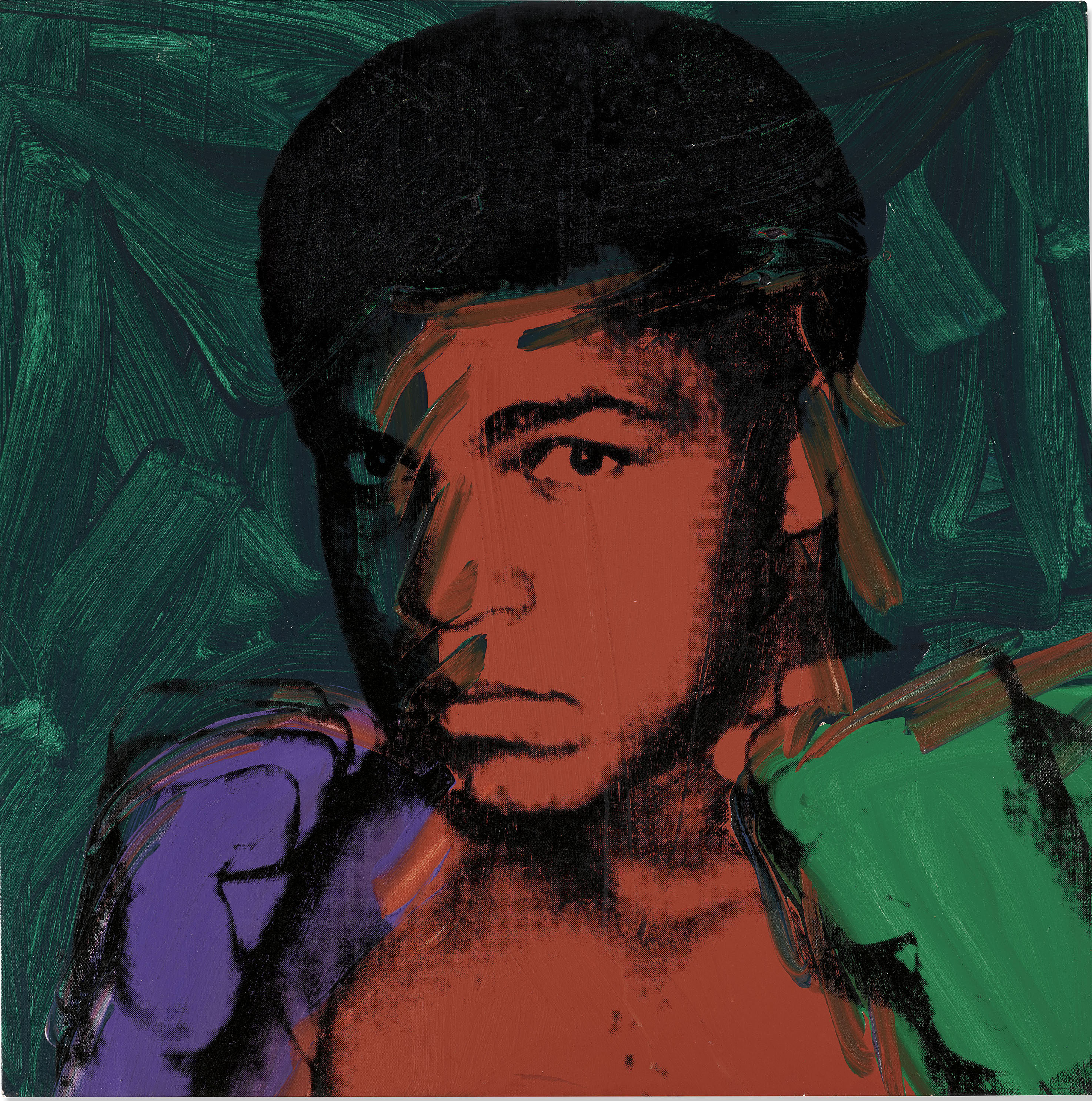
Andy Warhol, Muhammad Ali (1977) £4.97 million ($6.46 million). COURTESY CHRISTIE'S
Christie’s London Evening sale of contemporary art had few star lots—but only one that failed to find a buyer—yet it managed to pull in a total £56.2 million ($72.8 million), down little more than a quarter from the previous year’s comparable sale. Two lots, one by Christopher Wool and one by Glenn Ligon, were withdrawn before the sale, leaving nevertheless an outsize number of lots—56—for the time and venue. Christie’s managed the sale exceptionally well, including convincing the consignor of a Gerhard Richter constellation painting to accept a price two-thirds of the low estimate.
Overall, the sale continues to reinforce the impression that the contemporary art market has compressed toward works in the so-called middle market price band, below $5 million.
The night’s top lots were the late West Coast collector Richard L. Weisman’s commissioned portrait of Muhammad Ali by Andy Warhol, which made £4.97 million ($6.46 million). It was the lead lot among the ten sports figures depicted by the artist at Mr. Weisman’s request. Kareem Abdul-Jabbar, Jack Nicklaus, and O.J. Simpson were also legendary personalities from the series who sold better than their estimates. Jean-Michel Basquiat’s Mosque sold for £3.9 million ($5.13 million), falling below its low estimate but still ranking among the most valuable lots of the evening. The same was true of Sigmar Polke’s untitled work, which reached £3.13 million ($4.07 million) while also failing to reach the low estimate. David Hockney’s 2006 landscape Walnut Trees sold well at £3.25 million ($4.22 million), to come fourth among the lots sold by value.
Albert Oehlen’s Mission Rohrfrei (Down Periscope) from 1996 continued the artist’s market run, being the first of the top ten lots to achieve its price through aggressive bidding. The final price of £3.19 million ($4.14 million) reflected a hammer price of £2.65 million that edged slightly above its £2.5 million high estimate.
Several other lots that enjoyed aggressive bidding began the sale with strong momentum; they were all by painters now familiar to the market. Jordan Casteel’s Mom (2013) set a record price for the artist at £515,250 ($669,160), reflecting a hammer price well over the £250,000 ($324,700) high estimate. Another young female artist, Tschabalala Self, surfaced at the start of the sale with lively interest from potential buyers. Six telephone bidders jumped in early, overwhelming the three bidders in the order book held by Jussi Pylkkänen. The initial frenzy raised anticipation but the bidding for Spare Moment petered out over the £120,000 ($155,845) high estimate to sell eventually for a solid but perhaps less-than-hoped-for £170,000 ($220,780) on the hammer, or £212,500 ($276,000) with buyer’s premium. Self’s auction record, set in October 2019, remains substantially higher at $486,461 which in that case reached about five times the low estimate.
Later in the sale, an untitled work by Gotthard Graubner went for £491,250 ($678,000), following the artist’s success last year in a Day sale of a similar monochrome work (that one in gold) that sold for £150,000 ($194,810). In the year prior, another Graubner work sold in a Sotheby’s Evening sale was the first of the artist’s work to come to auction in nearly a decade.
Günther Förg’s untitled series of paintings on lead and wood sold for £1.33 million ($1.73 million), increasing his auction record by several hundred thousand dollars. Earlier in the sale, one of Förg’s decorative works a full 13 feet wide sold at the low estimate for £731,250 ($949,682).
Antoni Tàpies, the Spanish painter, achieved a record with his mixed-media assemblage, Pintura del Cubell, which sold for £851,250 ($1.11 million). The price reflected strong competition for a work that has been held in the same collection since 1988.
Grayson Perry did well with Emotional Landscape, which sold slightly better than his ceramic jar positioned similarly in the previous night’s sale. At Christie’s, the work made £187,500 ($243,510). Also following a strong sale from the previous night was Eddie Martinez, whose Cannibal Eyes made £347,250 ($451,000), over a £180,000 ($233,800) high estimate.
The final strong sale of the evening was Howard Hodgkin’s Like an Open Book from the collection of Jeremy Lancaster, which Christie’s has been selling over the course of several months. That work sold for £443,250 ($575,650), more than double the high estimate, with the buyer’s premium.
ADVERTISING
Content Courtesy of: adage.com
Written by: Jessica Wohl.
WENDY’S BEGINS ITS BIG BREAKFAST PUSH AND RIVALS ARE READY
Chains from McDonald’s to Chick-fil-A have cooked up ways to entice diners with their own breakfast lineups

Wendy’s tapped McDonald’s former chef Mike Haracz to promote its breakfast on social media and TV. Credit: Wendy's
Wendy’s is making its biggest attempt yet to snag a bite of the breakfast business, and its competitors are armed with deals that just so happen—OK, were absolutely, totally planned—to coincide with the launch.
Wendy’s officially launches its breakfast menu on March 2, though many of its restaurants are already serving the Breakfast Baconator and other delicacies.
Wendy’s has had limited success in past attempts to crack into the breakfast business. This time, it seems to be much more prepared—although so do its rivals. The fast-food restaurant chain announced its 2020 breakfast intentions back on Sept. 9 and unveiled its March 2 launch date on Feb. 4.
“Since everybody knows there’s a new entrant coming into the breakfast daypart, we would have expected it to be highly competitive, and that’s what we’re seeing,” Wendy’s CEO Todd Penegor said in a conference call on Feb. 26.
McDonald’s on Friday said it is calling Monday, March 2 "National Egg McMuffin Day." It’s offering anyone with its app a free Egg McMuffin from 6 a.m. to 10:30 a.m. on Monday, which of course is the same day as Wendy’s big rollout. McDonald’s has already been promoting value deals such as 2 for $4 offers on the Sausage McMuffin with Egg, Bacon Egg & Cheese Biscuit, and Bacon, Egg & Cheese McGriddles.
Wendy’s, meanwhile, hired McDonald’s former chef Mike Haracz to promote its breakfast on social media and on TV.
For months, Wendy’s has insisted that it is ready for the stepped-up efforts across the industry.
“Honestly, the louder the fight gets, the better it is for our breakfast business,” Kurt Kane, Wendy’s U.S. president and chief concept officer, said in October.
Wendy’s said on Feb. 26 that it plans to spend about $40 million to $50 million on breakfast advertising, as part of the total $70 million to $80 million dedicated to breakfast advertising this year, with the rest coming out of the ad funds it already gets from franchisees. The increased spending means Wendy’s working media weight will be up about 30 percent this year. The company is in a bit of a breakfast startup mode pointing out it expects to have a loss on its breakfast business in 2020, due to the investments it is making in marketing.
Others are making investments, too. Some Chick-fil-A restaurants, including those in the Chicago area, are offering a free breakfast item each Tuesday in March.
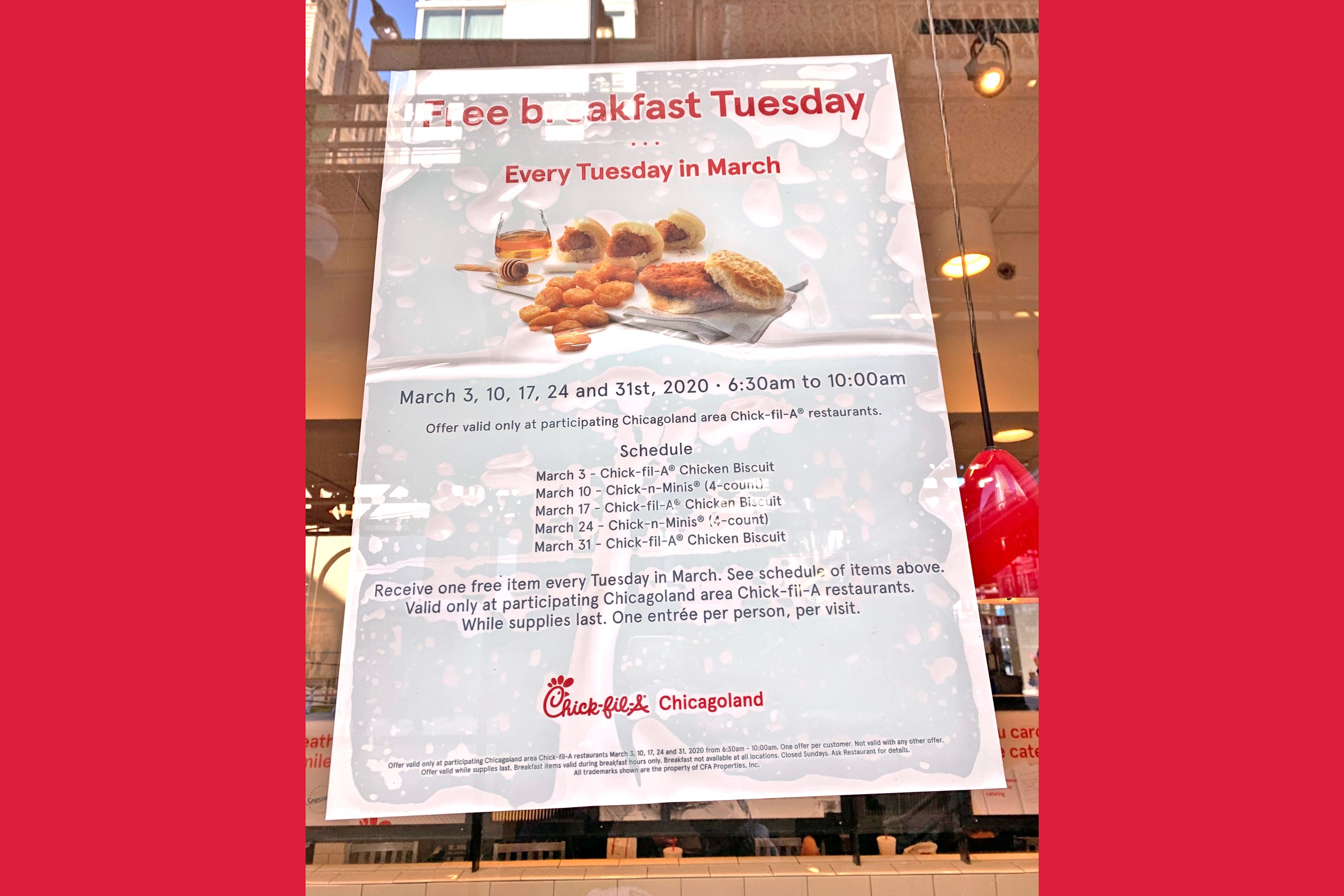
Some Chick-fil-A restaurants are offering free breakfast items each Tuesday in March. Credit: Jessica Wohl
Chick-fil-A for years has been promoting chicken for breakfast and has seen rivals including McDonald’s, and now Wendy’s, try to stake their claim.
“We believe this product easily goes head to head versus the competition and is far greater in terms of the overall flavor profile,” Wendy’s Chief Marketing Officer Carl Loredo said of the Honey Butter Chicken Biscuit sandwich at a pre-launch press event earlier this month.
Burger King said earlier this month that it has initiatives planned around breakfast, but didn’t elaborate.
Wendy’s is even taking aim at Starbucks with its Frosty-ccino, pointing out at the press event that the coffee drink has half the calories of a Starbucks Vanilla Frappuccino.
Other breakfast players are making their own moves. Panera this week announced unlimited coffee for $8.99 a month. Jack in the Box, which has offered breakfast items all day for years, is working on a new coffee.
Dunkin’, meanwhile, is now selling bags of bacon meant for “snackin’,” as the company spells it. For those keeping track, there are eight half-slices of sweet pepper bacon in a serving of Snackin’ Bacon, and six strips of Applewood smoked bacon on the Wendy’s Breakfast Baconator. (You’re welcome, cardiologists of America, for the expected increase in business.)
Dunkin’ also brought back its Egg White Bowl and Sausage Scramble Bowl, and added its Sausage, Egg & Cheese Wake-Up Wraps to its Go2s menu, at two for $3, through mid-May.
And for the oddest-sounding item amid all of this breakfast madness, Einstein Bros. Bagels introduced the “Bagelrito” nationwide on Feb. 27, following a five-restaurant test in the fall.
What’s a Bagelrito? So glad you asked. The bagel-meets-burrito concoction is two eggs, bacon, turkey sausage, three kinds of cheese, hashbrowns, salsa and green chilies stuffed in a flour tortilla, then wrapped into Asiago bagel dough and baked.
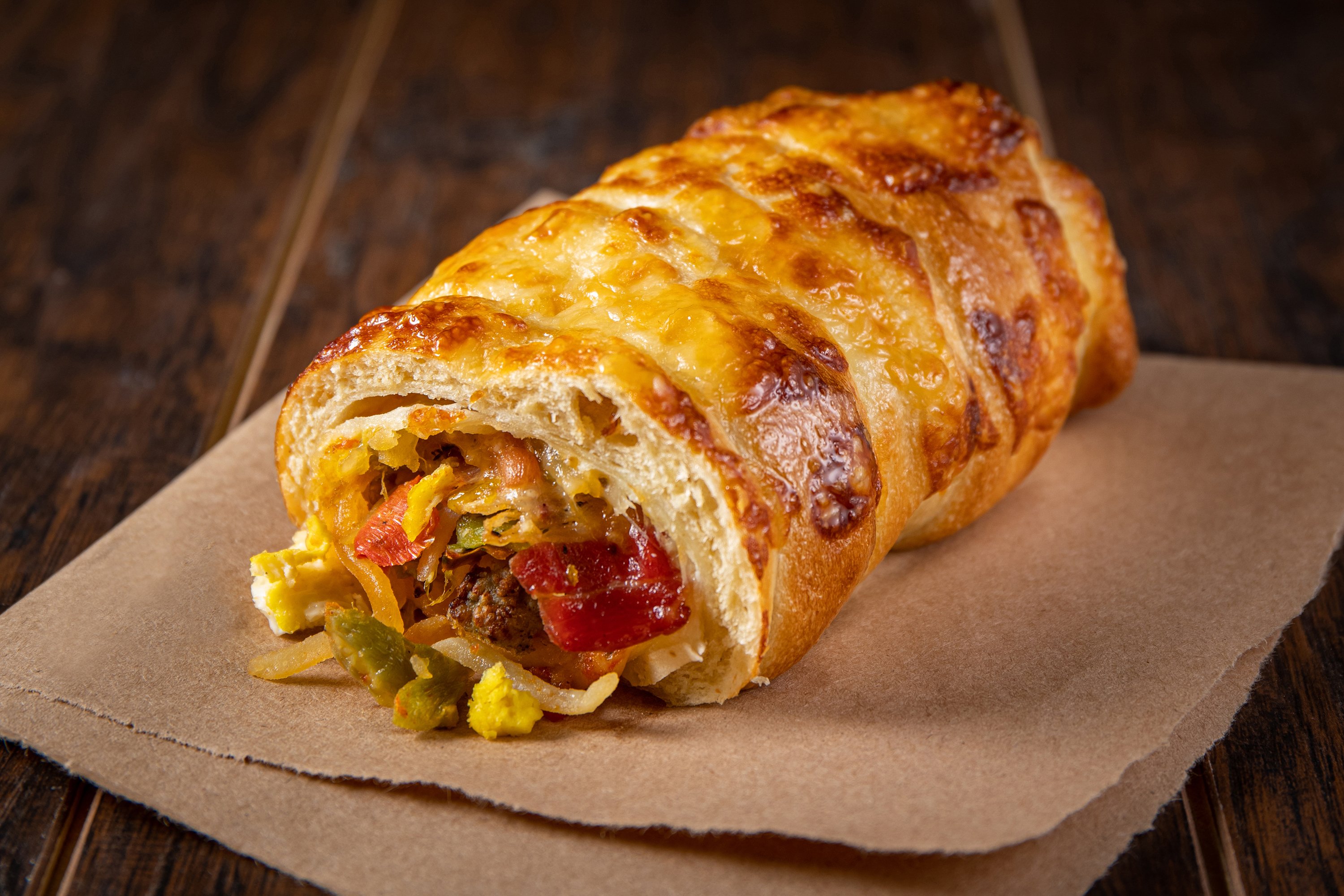
Einstein's Bagelrito Credit: Einstein Noah Restaurant Group
Content Courtesy of: adage.com
Written by: E.J. Schultz.
CORONA’S OWNER HITS BACK AT A SURVEY THAT SUGGESTED IT'S BEEN HURT BY CORONAVIRUS
It’s extremely unfortunate that recent misinformation about the impact of this virus on our business has been circulating,’ Constellation Brands said in a statement

A worker carries packages of Corona beer, a brand owned by Constellation Brands, as orders are prepared for delivery in the Euclid Beverage warehouse in Peru, Illinois, U.S Credit: Daniel Acker/Bloomberg
Corona parent company Constellation Brands today took aim at a survey put out by a PR agency that claimed people were cutting back on the beer because it shares the same name as the coronavirus. The survey, issued on Thursday by 5W Public Relations, claimed that “38% of beer-drinking Americans would not buy Corona under any circumstances now.”
“It’s extremely unfortunate that recent misinformation about the impact of this virus on our business has been circulating in traditional and social media without further investigation or validation,” Constellation CEO and president Bill Newlands said in a statement issued Friday afternoon. “These claims simply do not reflect our business performance and consumer sentiment, which includes feedback from our distributor and retailer partners across the country.” He added that “our company does not have much exposure to international markets such as China that have been most impacted by this situation.” (Anheuser-Busch InBev controls Corona globally.)
Constellation in its statement cited IRI retail sales trends showing that sales of Corona Extra increased by 5 percent in the four-week period ending Feb. 16, “nearly doubling the 52-week trend for the brand.”
5WPR’s survey of 737 American beer drinkers was conducted by phone on Feb. 25 and Feb. 26, according to the agency. The survey also reported that only 4 percent of regular Corona drinkers said they would stop drinking the brand, but 14 percent said they would not order it in a public venue. On Thursday, Ad Age asked 5WPR to clarify they 38 percent stat, in terms of if it included regular Corona drinkers. The agency responded that "the 38 percent of people who said they would not buy Corona under any circumstances now did not describe themselves as previous Corona-drinkers, they described themselves as beer-drinkers, in general."
The findings, which were released on Thursday, drew widespread media attention. By Friday morning, “38% of Americans,” was trending on Twitter. But much of the social media reaction was more directed at the intellect of anyone who would confuse the virus and the beer. Here, a sample:




BUSINESS
Content Courtesy of: adage.com
Written by: Bloomberg News.
WALMART DEVELOPING A MEMBERSHIP PROGRAM TO RIVAL AMAZON'S PRIME
New service will be called called Walmart+

Walmart Inc.’s battle with Amazon.com Inc. is going Prime time.
The world’s largest retailer is developing a paid membership program to challenge the internet giant’s Prime offering—which has become the default online shopping option for millions around the globe. The service, called Walmart+, will expand on the retailer’s existing grocery-delivery subscription service, which it introduced last year. Chief Customer Officer Janey Whiteside will spearhead the service’s development and rollout.
A Walmart spokeswoman confirmed the plans but declined to provide any details. Additional perks could include discounts on prescription drugs and fuel, according to Recode, which first reported the existence of the program.
Developing a broad-based membership program illustrates Walmart’s deep-seated concern that shoppers who defect to Amazon don’t often come back. The idea also runs counter to the ethos of founder Sam Walton, who famously refused to introduce the shopper-loyalty programs that are now commonplace at U.S. retailers. He argued that Walmart needed to treat each and every customer the same.
That said, Walmart has tried to mimic Prime before, testing a program called ShippingPass that it shuttered in 2017 upon the arrival of Marc Lore, who now runs Walmart’s U.S. e-commerce business.
The latest move is more ambitious than previous efforts, though, and aims to counter Amazon’s vise-like hold on the loyal shoppers who pay for the perks associated with Prime, which include free shipping and video streaming. Prime members spend about twice as much as other customers, and their willingness to splurge is a big reason why Amazon captured an estimated 40 percent of all sales growth at U.S. retail in the holiday quarter.
Since its debut in 2005, Prime has helped Amazon compete on price with physical retailers, allowing it to grow from an online bookseller to the largest online merchant of a wide range of goods. The company has tried to keep Prime members, who pay $119 a year for the service in the U.S., hooked with goodies like streaming video and music, and, more recently, free grocery delivery.
Amazon has also taken steps to lure lower-income shoppers into Prime memberships by offering monthly membership rates rather than forcing members to pay annually. Like Walmart, it is also delivering groceries to food-stamp recipients. Such efforts show Amazon is looking to broaden its customer base from affluent shoppers craving convenience to making Prime membership an everyday necessity.
Whiteside, the Briton who’s heading Walmart+, has become a powerful player at Walmart since her arrival from American Express in 2018. Chief Executive Officer Doug McMillon has tasked her with courting more upscale shoppers and merging online and brick-and-mortar operations so that customers have a similar experience no matter where or how they shop. She’s also created a so-called product team, led by Chief Product Officer Meng Chee, which is using technology to improve the customer experience.
Using Walmart’s existing grocery delivery service as the backbone of Walmart+ makes sense, as it’s the one business where Walmart has a clear advantage over Amazon, with more than 20 percent market share in the $800 billion category. Walmart already delivers groceries from more than 1,600 U.S. stores and is testing a service that sends employees right into customers’ homes to put the food away in their fridges.
Walmart’s Delivery Unlimited service currently costs $98 a year or $12.95 monthly, and uses a free 15-day trial to entice new members. Customers can also pay a per-delivery fee, with no membership.
TECH
Content Courtesy of: theverge.com
Written by: Jay Peters
Facebook’s 3D photos can now be made using single-camera phones
You previously needed to use a dual-camera device

Illustration by Alex Castro / The Verge
Facebook will now let you post 3D photos to your timeline from the Facebook app even if you have a phone with a single camera, the company announced today. In theory, this should make it possible for a lot more phones to take 3D photos — and Facebook says it also means you can use your front-facing camera to take take 3D selfies.
The feature, which was first made available in October 2018, was previously exclusive to phones that had two or more cameras that could take portrait mode shots. Previously, 3D photos relied on using each camera to take an image that Facebook could use to create the “depth” in a 3D picture.
This new single-camera technique uses machine learning to infer the three-dimensional structure of an image to create the 3D effect, according to Facebook. Here’s an animation the company provided of what that depth generation process looks like:

And here’s an example from Facebook of how the tech could look in an image on your timeline:

Facebook says anyone with an iPhone 7 or higher, or “a recent midrange or better Android device,” should be able to use the 3D photo tool in the main Facebook app. However, it doesn’t seem to have fully rolled out just yet — right now, I can only make 3D photos using images taken in portrait mode on my iPhone 11 Pro.

Content Courtesy of: theverge.com
Written by: Makena Kelly
The World Health Organization has joined TikTok to fight coronavirus misinformation
Its first video shows ways people can protect themselves

The World Health Organization launched a TikTok account on Friday as part of its efforts to cut through coronavirus misinformation online. A specialized public health agency of the United Nations, WHO is one of the leading organizations working to contain the spread of the virus.
In WHO’s first video, Benedetta Allegranzi, technical lead of infection prevention and control, describes measures people can take to protect themselves from the novel coronavirus and directs them to the organization’s website for additional information.
“We are joining [TikTok] to provide you with reliable and timely public health advice,” WHO wrote in the description of its first video.
TikTok has been flooded with memes about the novel coronavirus over the past few weeks, with some users pretending to be infected. In one case, a teenager made a video suggesting that their friend was the first Canadian confirmed to have caught the virus. TikTok did not immediately respond to a request for comment.
The launch of the TikTok account is part of WHO’s work to get accurate information concerning the novel coronavirus to people online. According to the MIT Technology Review, WHO and the Centers for Disease Control and Prevention have spent the last couple of weeks of the outbreak fighting misinformation regarding the virus on platforms like Facebook, Twitter, Tencent, and TikTok.
Information from WHO already tops Google results for search queries about the novel coronavirus. Facebook users scrolling through their news feeds are also met with messages directing them to visit government websites for information on the virus. Twitter users see a message that says “Know the facts” and directs them to visit the CDC’s website for “the best information on the novel coronavirus” when they search for content related to the virus. TikTok also links users who search for virus-related content to the WHO website.
The coronavirus information partnerships are similar to how platforms reacted to criticism over anti-vaxx content on their platforms over the past few years.
WHO has also made strides to post accurate novel coronavirus information to its other social media accounts like Instagram. The organization’s Instagram feed is filled with infographics outlining how people can protect themselves from the virus.
WHO did not immediately respond to a request for comment from The Verge.

Content Courtesy of: theverge.com
Written by: Jay Peters
Apple reportedly releasing an iPad keyboard with a trackpad later this year
It will likely launch with the next iPad Pro, according to The Information

Apple is planning to release a new iPad keyboard with a built-in trackpad later this year, according to The Information. The new accessory is likely going to release alongside the next version of the iPad Pro, said The Information’s source.
Adding a trackpad to an iPad keyboard would be yet another move from Apple to bring functionality typically associated with a laptop to the company’s popular tablet line. iPadOS already has mouse support, but it’s an extension of the iPad’s AssistiveTouch technology and you have to dig into the accessibility menu to turn it on. And the on-screen mouse pointer isn’t the usual little black arrow you might be used to on your computer — it’s a big, semi-opaque circle that has a dot in the middle.
So right now, Apple doesn’t seem to be pushing you to use a mouse on an iPad. But if the company does release an iPad keyboard with a trackpad, it seems possible mouse support could become a more visible feature in iPadOS in an upcoming software update.
And just yesterday, at the company’s annual shareholder meeting, Apple software chief Craig Federighi said, “If you like what you’ve seen us do with iPadOS, stay tuned, we’re going to keep working on it.” So it seems we should, unsurprisingly, expect new iPadOS updates at some point that lean more into the device’s dual purpose as a tablet and PC.
Perhaps Apple has seen positive response to mouse support — my colleague Sam Byford felt it was pretty good — and will make it a more core part of iPadOS along with this rumored new keyboard case. Now, Apple just needs to pull the reverse trick and add a touchscreen to a Mac.

CULTURE
Content Courtesy of: theverge.com
Written by: Jay Peters
Tinder swipes right on ‘Swipe Night’ by renewing it for a second season
The in-app Choose Your Own Adventure-style series returns this summer

Tinder has renewed Swipe Night, its in-app Choose Your Own Adventure-style series, for a second season that’s expected to premiere this summer, as first reported by Variety. The first season debuted last October.
Swipe Night is a weekly series, with each episode about five minutes long. In each episode, you have to swipe to select different options about paths and choices presented to you, and those decisions are added to your profile in the hopes that they can be conversation starters with potential matches.
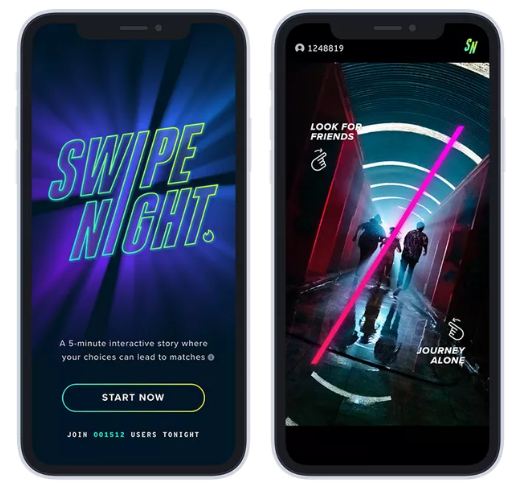
“Entertainment has always been a human connector,” said Elie Seidman, Tinder CEO, in a statement given to The Verge. “We had a theory that our members would find this completely new and innovative experience natural to their Tinder experience — and they did. We couldn’t be more thrilled to bring a new season of Swipe Night to Tinder this summer and give our members another opportunity to form connections and start conversations.”
“Millions” of people tuned into the first season and helped increase matches by 26 percent and conversation on the app by 12 percent, Tinder says. Karena Evans will return as the director for the new season, and the company also says it will release the first season of Swipe Night internationally on March 14th.
Broomchallenge: Eggs, equinox and misinformation
Content Courtesy of: bbc.com/
Written by: Rozina Sini
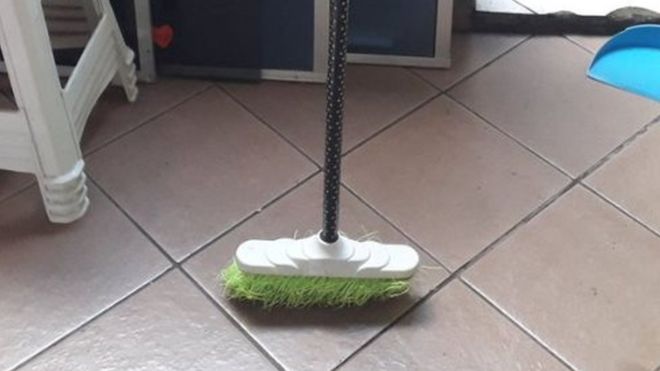
It is the social media challenge taken up by thousands but the scientific claims behind it are nonsense.
The #broomchallenge has people all over the world photographing and filming their brooms standing upright without any support.
Many people have cited Nasa as the inspiration to do this, and/or posted claims of gravitational or celestial phenomena as the reason behind the balancing brooms.
"Nasa said today was the only day a broom can stand up on its own because of the gravitational pull," posted a Twitter user in the US on Monday in footage which has been viewed millions of times and emulated by thousands.
However, the space agency does not appear to have made any public statement about the Earth's gravitational effect on brooms.
Freestanding brooms have nothing to do with planetary alignments, the full moon, or gravitational pulls, despite the claims of some social media users.
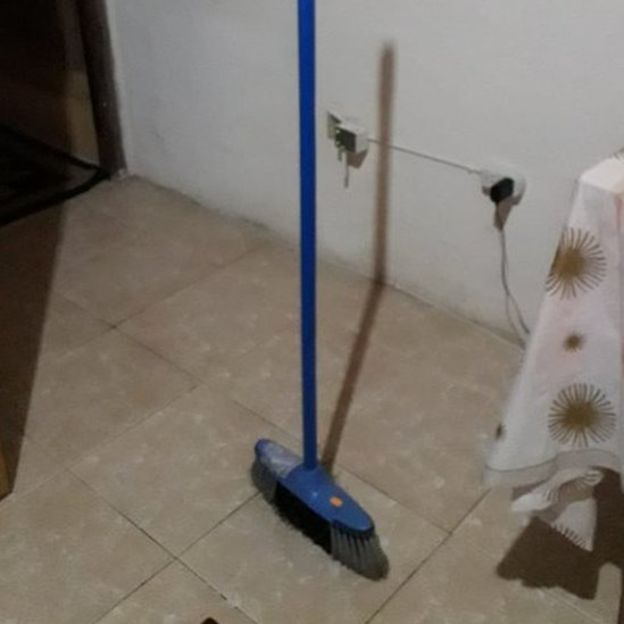
So where has this misinformation come from?
Although the earliest uses of #broomchallenge this year were from users in Mexico around 4 February, one of the first posts to tag Nasa came from a Twitter user in Brazil on 8 February.Fact-checking website Snopes says the broom challenge was widely circulated before in February 2012, and is another version of an egg-balancing trick which was attributed to the spring equinox.
During an equinox the Earth's north and south poles are not tilted towards or away from the sun, which also means the duration of daylight is almost the same at all points on the Earth's surface.
In a TV broadcast in March 2012, now uploaded to YouTube, CNN meteorologist Chad Myers explained it was possible to balance a broom or an egg at any time of the year not just the spring equinox."If you set the egg up long enough, the yolk will come down to the bottom of the egg and that will be your centre of gravity down there," he explained. "Keeping a low centre of gravity makes a fast race car but also will make brooms stand up."
'Party trick'
Dr Becky Smethurst, an astrophysicist from the University of Oxford, told the BBC she could not believe the misinformation being spread online.
"Broom balancing itself is not that impressive. It's a good party trick.
"The broom is wide at the bottom and at the right angle can be balanced
"We feel the same gravitational pull at all times of the year, so no matter whether it's the the spring equinox or not, the way the Earth is tilted would never be the cause of ordinary objects just balancing.
"Not even if the Earth was tilted a huge amount would it make a difference.
"When I saw this today on social media and couldn't believe what I was seeing in terms of the misinformation that was spreading.
"It highlights the importance of social media verification and using trusted sources from the scientific community."
As one Twitter user commented: "Your broom is able to stand on its own on any day of the year, and Nasa didn't say today was special regarding that"
While LA based News 15 meteorologist Cory Smith took a more humorous approach.
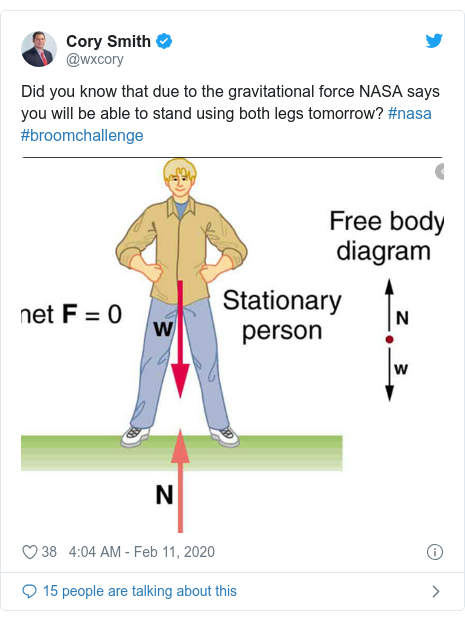
He also sees the positive in addressing such misunderstandings.
"While it is discouraging to see people believe a false premise for something like this, it still makes for a fun and easy social media challenge and a nice little experiment to talk about physics and the centre of gravity," Smith told the BBC.
It is not the first time Nasa has been linked to nonsense on social media. In 2016, 17 million people watched a Facebook video stream supposedly live broadcast from the International Space Station,
However, the agency confirmed the footage was from an older spacewalk.
Nasa have been approached for comment.
TikTok teenager's video sparks domestic abuse debate
Content Courtesy of: bbc.com/
Written by: Kris Bramwell

A teenager is asking people to be alert to the signs of domestic violence with a video she has created on social media.
Sixteen-year-old Amber uses make-up to gradually cover her face to resemble bruises as she lip syncs to the Lily Allen track Not Fair.
The video has been viewed more than 1.7 million times on the video-sharing platform TikTok and has also been liked more than 196,000 times so far.
The A-level student told the BBC that she was motivated to make the video because a family friend had experienced abuse.
She said: "The message of the video is don't ignore the signs of domestic abuse. If you have the slightest concern, bring it up with the person.
"I feel domestic abuse is something that should have more awareness."
'I'm a survivor'
In response, some women have shared their own experiences of domestic abuse. One user posted: "Been here, came out the other side."
And Amber has replied offering support. "I'm sorry this has happened to you," she says. "But it shows how strong you are that you came out the other side."
Another person said she wished she had known the signs of domestic abuse earlier, and one woman warned people to be aware that abusers "tend to hit where it won't be seen".
Amber's creative use of her make-up has been praised for its impact.
A commenter told Amber: "Thank you for doing this. I'm a survivor."
"This is so powerful. I'm going through this with a friend now who always makes excuses and brushes it off," added another viewer.

While other TikTokers have created similar videos, Amber's appears to have produced by far the biggest reaction.
Some of it has been critical, with people debating whether the content is too dark for the platform or too serious an issue for "pretend" videos.
One user posted that domestic abuse "really does happen to people and they don't make TikToks about it".
Amber has responded that the video "is not intended to... bring back memories for survivors".
Indeed, one person who had experienced domestic violence told her that she had "triggered nothing" with the post.
Amber says: "I didn't want people to think the video meant any harm. It has a good message and was not created to gain popularity for myself."
'Speak up''
According to the Office for National Statistics, an estimated 2.4 million adults aged 16 to 74 years experienced domestic abuse in the year up to March 2019 in England and Wales, including 1.6 million women and 786,000 men.
A man responding to Amber's video said: "Men go through this as well and a lot more should be able to speak up about it."
The Home Office has published advice on how to recognise, report and receive help relating to domestic abuse.
